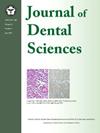Evaluation of the physical and mechanical properties of 3D-printed resin for orthodontic fixed lingual retainers: An in vitro study
IF 3.4
3区 医学
Q1 DENTISTRY, ORAL SURGERY & MEDICINE
引用次数: 0
Abstract
Background/Purpose
Fixed lingual retainers (FLRs) often experience structural instability, including poor adaptation, and the untwisting of spiral wires, which can lead to unwanted tooth movement. Digital workflows have enhanced the appliance's accuracy. This study evaluated the water sorption (Wsp), water solubility (Wsl), staining resistance, and flexural performance of three-dimensionally printed resin (3DR) to determine its optimal design for FLRs.
Materials and methods
Cylindrical 3DR specimens were immersed in distilled water and artificial saliva for 7, 14, and 30 days. Wsp and Wsl were measured according to ISO 4049 guidelines. Color stability was analyzed after 7 days of immersion in staining solutions using the CIEDE2000 formula. Straight 3DR specimens with various cross-sectional shapes and dimensions underwent a three-point bending test, comparing mechanical properties to multistrand stainless-steel wire (MSW). Statistical analysis was performed using a one-way ANOVA with Tukey's post-hoc test (P < 0.05).
Results
Wsp and Wsl values remained within ISO standards, with no significant changes over time. Specimens exposed to red wine, grape juice, and curry exhibited color changes exceeding the acceptability threshold of 1.77, while other solutions caused minimal discoloration. Hemi-elliptical cross-sections demonstrated significantly greater flexural strength than round designs. Although all 3DR specimens fractured before reaching the 2.0-mm deflection limit, some designs exhibited comparable bending strength to MSW while maintaining sufficient flexibility for physiological tooth movement.
Conclusion
A hemi-elliptical 3DR design (1.0 mm thick and 2.0 mm wide) demonstrated stability in the oral environment, moderate stainability, and mechanical performance comparable to MSW, supporting its feasibility for FLRs.
正畸固定舌固位体3d打印树脂的物理力学性能评价:体外研究
背景/目的固定舌固位器(flr)经常经历结构不稳定,包括适应性差,螺旋钢丝解扭,这可能导致不必要的牙齿运动。数字化工作流程提高了设备的准确性。本研究评估了三维打印树脂(3DR)的吸水性(Wsp)、水溶性(Wsl)、耐染色性和弯曲性能,以确定其用于flr的最佳设计。材料和方法将3DR圆柱形标本分别浸泡于蒸馏水和人工唾液中7、14和30天。Wsp和Wsl根据ISO 4049指南进行测量。使用CIEDE2000配方在染色溶液中浸泡7天后分析颜色稳定性。采用不同截面形状和尺寸的直3DR试件进行三点弯曲试验,比较其与多股不锈钢丝(MSW)的力学性能。统计学分析采用单因素方差分析和Tukey事后检验(P <;0.05)。结果swsp和Wsl值保持在ISO标准范围内,随时间无明显变化。暴露在红酒、葡萄汁和咖喱溶液中的样品的颜色变化超过了1.77的可接受阈值,而其他溶液的变色程度最小。半椭圆截面的抗弯强度明显高于圆形设计。尽管所有3DR试件在达到2.0 mm挠度极限之前都发生了断裂,但一些设计在保持足够的牙齿生理运动柔韧性的同时,表现出与MSW相当的抗弯强度。结论半椭圆3DR设计(1.0 mm厚,2.0 mm宽)在口腔环境中具有稳定性,中等的不稳定性,力学性能与MSW相当,支持其作为flr的可行性。
本文章由计算机程序翻译,如有差异,请以英文原文为准。
求助全文
约1分钟内获得全文
求助全文
来源期刊

Journal of Dental Sciences
医学-牙科与口腔外科
CiteScore
5.10
自引率
14.30%
发文量
348
审稿时长
6 days
期刊介绍:
he Journal of Dental Sciences (JDS), published quarterly, is the official and open access publication of the Association for Dental Sciences of the Republic of China (ADS-ROC). The precedent journal of the JDS is the Chinese Dental Journal (CDJ) which had already been covered by MEDLINE in 1988. As the CDJ continued to prove its importance in the region, the ADS-ROC decided to move to the international community by publishing an English journal. Hence, the birth of the JDS in 2006. The JDS is indexed in the SCI Expanded since 2008. It is also indexed in Scopus, and EMCare, ScienceDirect, SIIC Data Bases.
The topics covered by the JDS include all fields of basic and clinical dentistry. Some manuscripts focusing on the study of certain endemic diseases such as dental caries and periodontal diseases in particular regions of any country as well as oral pre-cancers, oral cancers, and oral submucous fibrosis related to betel nut chewing habit are also considered for publication. Besides, the JDS also publishes articles about the efficacy of a new treatment modality on oral verrucous hyperplasia or early oral squamous cell carcinoma.
 求助内容:
求助内容: 应助结果提醒方式:
应助结果提醒方式:


